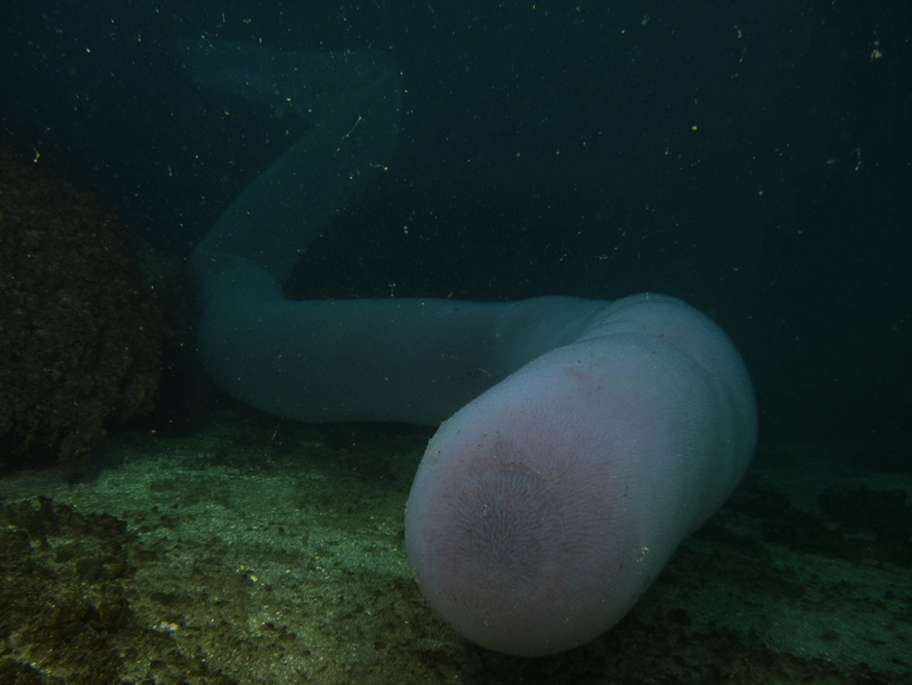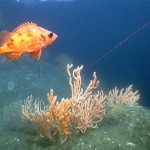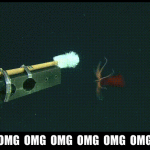So on June 7th I was all, ‘Facebook, what’s happening today?’ and as I’m scrolling through my feed I see this picture–posted by a scuba diver from a small group of islands in the middle of the Atlantic Ocean called the Azores–and I know my day is about to get real interesting:

This is a giant pyrosome, one of the strangest animals on Earth. Over the last few weeks I’ve been talking with the diver who captured this shot, Devin Leary, and, y’all, there is something very crazy happening in the Azores right now! But first, what are pyrosomes anyway? To quote myself from another article I wrote:
“If the Borg and the Clone Wars had a baby it would be a pyrosome. One long pyrosome is actually a collection of thousands of clones, with each individual capable of copying itself and adding to the colony. And like members of the Borg, which are mentally connected, pyrosome members are physically connected– actually sharing tissues. And while the Borg live in a big, scary ship, pyrosomes are the big scary ship. The whole colony is shaped like a giant thimble with a point on one end and an opening on the other”
Each member of the colony sucks in water from the outside of the colony, filters it for food and squirts the filtered water out into the big hollow space in the middle. Pyrosomes can be pretty freaky looking, but like many ocean giants, they’re actually filter feeders.
I love hearing about large pyrosome sightings because animals this big are very hard to find. One pyrosome sighting like this is incredibly lucky, but oh it gets so much better. Did you know that right now, all around the Azores, right now…did I say right now? There are pyrosomes ALL OVER THE PLACE?! Many are roughly a meter in length, but some are 8-10 meters (~26-33 feet) long! This is the first time I’ve been privy to a mass occurrence of giant pyrosomes in real time, and I’m freaking out! And I’m not the only one: Mr. Leary has been on the scene documenting these gentle giants as they troll through the cool waters, and he’s never seen anything like this. Devin told me on Facebook that in “past years I think I’ve seen one or two but this year we’ve been seeing multiple per week!” Even better, this past Sunday Mr. Leary estimates he saw around 50 pyrosomes!
Devin’s not the only one. Professor João Pedro Barreiros told me by email that, “as far as I remember from more than 30 years of continuous diving in the Azores (and this includes literally hundreds of hours searching vast areas freediving) this is the first year that I’m seeing pyrosomes on an almost daily basis!”
The first time I saw a pyrosome I nearly cried, and that animals was no bigger than a jellybean. I dream of seeing pyrosomes like this. One diver and marine biology student, Pedro Tomás, told me a few days ago by email that “the ones we saw this week, one of them I could fit inside.” OH MY GOSH I WANT TO GO RIGHT NOW.
But what exactly is happening here? Where are these pyrosomes coming from? Why now? What species? To answer in order: I don’t know, I have no idea, haven’t got a clue, I think maybe it’s Pyrostremma spinosum, but I really have no idea! Mr. Tomás tells me he usually sees a few around this time, but from the sound of it this year is way out of the ordinary.
How long will this last? Nobody knows. The water in the Azores is starting to warm from all the summer sun, so Mr. Leary is concerned he may not see them for much longer. Dr. Barreiros is collecting observations from other divers, and Mr. Leary is working with Dr. Barreiros to take a few small tissue samples, which can hopefully be used to make an ID based on morphology and DNA sequences.
In the meantime, if you’re in the Azores and want a shot at spotting a pyrosome, I’d suggest getting in touch with Devin Leary and his dive shop, Arraia Divers. And if you’ve seen a pyrosome, please post your sighting on JellyWatch.org. Maybe with enough reports we can learn something new about these strange and mysterious creatures!







I have worked for 5 years as a dive instructor in the Azores. Every year I have seen that phenomenon… Not just this year.
Interesting Nélio! Where are you located? I’ve been hearing both–some people are seeing about the same number as years past but others are seeing way more than usual. I’m wondering if there are spots with more animals each year and spots where they are uncommon.
In São Miguel. I think that what happens is sometimes they show up earlier in the year when people aren’t diving as often…
I am currently working at Season Challenge Dive Center, in Ponta Delgada – São Miguel Island (Azores). We started to see these amazing creatures in May during our coastal dive trips and we are still seeing them in July. Some of the colonies were small but others were huge! We have seen also several species of fish eating these colonial organisms.
You can see some photos that I took on our facebook page (https://goo.gl/j9dpJF)
Hope this information will help with your research
Best regards,
Natália
Thanks Natália, this is great info!
That seems very possible! In your experience what time of year do you usually see them?
here’s a deep thought
these animals are arriving because the earthquake that been predict is about to cause a great disturbance on sea floor level,
My guess is there is something special about the currents this year, or past conditions that resulted in more animals (like more food last year, for example). Pyrosomes live in the pelagic zone, though I’m not sure what their distribution is in the water column within and between locations. I’m hypothesizing they’re moving laterally due to differences in current, rather than vertically.
I’m not an earthquake expert, but they usually occur at places where the plates are colliding, and the Azores is located in an area where plates are spreading apart.
Is this abundance perhaps related to the overfishing of species that might nibble on these invertebrates and the overall “rise of slime” phenomenon?
P.S. In the 1970s, one of the old “men’s adventure magazines,” either Argosy or True, carried photos of one these with the claim it was 60 feet long.